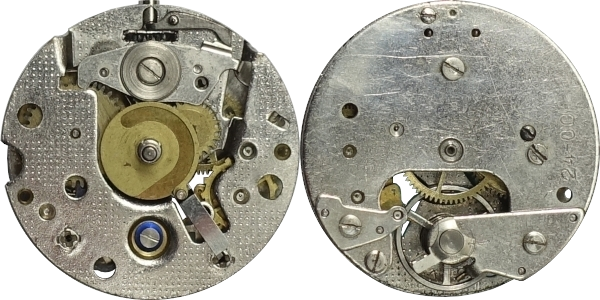The caliber UMF 24 from the VEB Uhrenkombinat Ruhla (UMF = Uhren- und Maschinenfabrik = watch and machinery factory) is probably the best-known mechanical movement built in the former GDR. Around 130 million of these simple and inexpensive pin lever movements are said to have been built between 1963 and 1990, many of them for export.

There is a wide range of 24-xx variants of this caliber, including those without seconds, with small seconds, with central seconds, with digital display and with or without jewels.
We will take a look at the UMF 24-39 caliber, which was designed for the small travel alarm clocks called Sumatic and midimatic. In contrast to classic wristwatch movements with an alarm function, such as the AS 5008 or the Junghans J89, this movement has no alarm function of its own! It merely serves to close an external circuit that causes a buzzer to sound. We’ll take a look at how this works in a moment.
The UMF 24-39 was created in 1968 at the VEB Uhrenkombinat Ruhla. The Sumatic travel alarm clocks with dimensions of just 56 x 40 x 19 mm were also produced there. The small alarm clock was awarded a gold medal at the International Leipzig Trade Fair in 1968.

Probably in the mid-1970s, the midimatic travel alarm clock followed, which is available in many colorful variants. The oldest mention of the midimatic that I could find was in the magazine Uhren und Schmuck from 1976. 94 x 44 x 25 mm in size, it is slightly larger than the Sumatic.

Let’s first take a look at the inside of the Sumatic alarm clock pictured above:

At the top right is a switch that can be used to activate and deactivate the alarm function. Directly below is the gold-colored buzzer for the alarm tone. On the left-hand side is a 1.5 V button cell, e.g. a Varta V13GA. The movement is located under the button cell.
Although the alarm clock has a battery, the movement must be wound by hand. This is done using the button on the side. If you pull it, you can set the time. The alarm time is set by turning the plastic crystal in front of the dial. The battery is therefore only used to sound the buzzer at the set alarm time!
And this is what the alarm clock sounds like when the buzzer is in operation:
The movement can be removed from the case as follows:
- Remove the three clips on the inside of the case
One of these can be seen in the picture above, approximately in the middle at the bottom edge. - Remove the front panel including the crystal from the front
The crystal does not need to be removed. - Lift off the hour and minute hands
The hand for the alarm time is not removed, but remains on the dial! - Remove two screws on the inside of the case that hold the dial in place.
- Lift off the dial
- Remove the movement to the front
For comparison, the inner side of the midimatic:

It works in the same way as the Sumatic. However, instead of a button cell, an AA battery is used here. And the case consists of two parts. The inner part can simply be removed from the back to access the movement. There is therefore no need to remove any retaining clips.
There is also an audio sample of the midimatic:
Let us now take a closer look at the movement, the UMF 24-39.

The technical data of the movement can be found here:
Ruhla UMF 24-39 – Watch Movements Archive
The movement differs from the simple UMF 24-30 only in two parts:
- A modified hour wheel in the center of the movement

- A small metal clip that conductively connects the hour wheel to the movement plate. This can be seen at the movement illustration above on the dial side at around 5 o’clock.

In particular, the movement itself has no mount for the alarm hand. This is held on the back of the dial by a metal tube encased in plastic.

In the right-hand part of the picture, the hour wheel shown above has been placed next to the tube for the alarm hand. In reality, of course, the two parts fit into each other. These two parts cause the buzzer to sound at the alarm time. How does this work?

The dial and movement plate are both part of the circuit, which must be closed for the buzzer to sound. The hour wheel is conductively connected to the movement plate, the alarm hand is conductively connected to the dial. There is therefore no connection between the dial and the hour wheel. Most of the time, the small dent on the hour wheel slides along the outside of the plastic insulation of the alarm hand. At one point, however, this has a small slit which ensures that both parts are conductively connected for about five minutes. This closes the circuit and the buzzer sounds. The following picture shows this schematically in a circuit diagram:

An ingeniously simple solution to turn a UMF 24 with a buzzer and a battery into an alarm clock!

Ho ritrovato una mia Sumatic, dimenticata dopo anni di uso negli anni 70. L’ho rimessa in fumzione, revisionato il movimento ancora ben funzionante. Ha più di 50 anni così ben portati.
Hi, i have an old Ruhla Sumatic alarm clock not working with one part missing (the little connection like a hair). Is there any watch repairer you may know who could fix my Ruhla? Thanks for your attention. Best Regards. Salvatore Pistola from Rome, Italy
No, I don’t. I would try to find a spare Sumatic on ebay and try it myself.